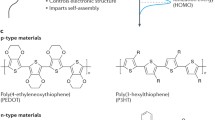Conducting polymers have received much attention recently as organic thermoelectric materials, because of such advantages as plentiful resources, easy synthesis, easy processing, low cost, low thermal conductivity, and easy fabrication of flexible, light, and printable devices with large area. Many reports on organic thermoelectric materials have recently been published. We have studied conducting polymers as organic thermoelectric materials since 1999. During these investigations, we found that the thermal conductivity of conducting polymers did not increase even though electrical conductivity increased; this was a major advantage of conducting polymers as organic thermoelectric materials. We also observed that molecular alignment was one of the most important factors for improvement of the thermoelectric performance of conducting polymers. Stretching of conducting polymers or their precursors was one of the most common techniques used to achieve good molecular alignment. Recently, alignment of the clusters of conducting polymers by treatment with solvents has been proposed as a means of achieving high electrical conductivity. Hybridization of conducting polymers with inorganic nanoparticles has also been found to improve thermoelectric performance. Here we present a brief history and discuss recent progress of research on conducting polymers as organic thermoelectric materials, and describe the techniques used to improve thermoelectric performance by treatment of conducting polymers with solvents and hybridization of conducting polymers with Bi2Te3 and gold nanoparticles.
Similar content being viewed by others
References
The White Paper on Energy Usage 2013, Agency of Natural Resources and Energy, Government of Japan (2013), p. 101, Fig. 211-1-2.
N. Toshima, Macromol. Symp. 186, 81 (2002).
H. Yan and N. Toshima, Chem. Lett. 28, 1217 (1999).
H. Yan, T. Ohno, and N. Toshima, Macromol. Mater. Eng. 286, 139 (2001).
Y. Hiroshige, M. Ookawa, and N. Toshima, Synth. Met. 157, 467 (2007).
H. Yan, N. Sada, and N. Toshima, J. Thermal Anal. Calorim. 69, 881–887 (2002).
T. Luo, D. Billap, T. Waechtler, T. Otto, M. Teader, O. Gordan, E. Sharemet, J. Martin, M. Hietschold, D.R.T. Zahn, and T. Gessnar, J. Mater. Chem. A 1, 7576 (2013).
G.-H. Kim, L. Shao, K. Zhang, and K.P. Pipe, Nat. Mater. 12, 719 (2013).
M. Takashiri, K. Miyazaki, S. Tanaka, J. Kurosaki, D. Nagai, and H. Tsukamoto, J. Appl. Phys. 104, 084302 (2008).
N. Toshima, M. Imai, and S. Ichikawa, J. Electron. Mater. 40, 898 (2011).
N. Toshima and N. Jiravanichanun, J. Electron. Mater. 42, 1882 (2013).
C.D. Dimitrakopoulos and P.R.L. Malenfant, Adv. Mater. 14, 99 (2002).
S.R. Forrest, Nature 428, 911 (2004).
A.G. MacMiarmid, Angew. Chem. Int. Ed. 40, 2581 (2001).
F. Garnier, R. Hajlaoui, A. Yassar, and P. Srivastava, Science 265, 1684 (1994).
O. Bubnova, Z.U. Khan, A. Malti, S. Braun, M. Fahlmen, M. Berggren, and X. Crispin, Nat. Mater. 10, 439 (2011).
Y. Shinohara, Handbook on Thermoelectric Technology (Tokyo: NTS, 2008), pp. 307–311.
D.K. Taggart, Y. Yang, S.-C. Kung, T.M. McIntire, and R.M. Penner, Nano Lett., 11, 125, 2192 (2011).
T. Takano, H. Masunaga, A. Fujiwara, H. Okuzaki, and T. Sasaki, Macromolecules 45, 3859 (2012).
Q. Wei, M. Mukaida, Y. Naitoh, and T. Ishida, Adv. Mater. 25, 2831 (2013).
F.D. Rosi, B. Abeles, and R.V. Jensen, Phys. Chem. Solids 10, 191 (1959).
X.B. Zhao, X.H. Ji, Y.H. Zhang, and B.H. Lu, J. Alloys Compd. 368, 349 (2004).
M.R. Dirmyer, J. Martin, G.S. Nolas, A. Sen, and J.V. Badding, Small 5, 933 (2009).
N. Watanabe and N. Toshima, Bull. Chem. Soc. Jpn 80, 208 (2007).
N. Watanabe, J. Kawamata, and N. Toshima, Chem. Lett. 33, 1368 (2004).
M. Takashiri, S. Tanaka, M. Takiishi, M. Kihara, K. Miyazaki, and H. Tsukamoto, J. Alloys Compd. 462, 351 (2008).
N. Toshima, N. Jiravanichanun, and H. Marutani, J. Electron. Mater. 41, 1735 (2012).
N. Toshima, Handbook on Thermoelectric Technology (Tokyo: NTS, 2008), pp. 320–326.
E. Pinter, Z.A. Fekete, O. Berkesi, P. Makra, and C. Visy, J. Phys. Chem. C 111, 11872 (2007).
A.N. Aleshin and E.L. Alexandrova, Phys. Solid State 50, 1978 (2008).
N. Mateeva, H. Niculscu, J. Schlenoff, and L.R. Testardi, J. Appl. Phys. 83, 3111 (1998).
Acknowledgements
This work was financially supported by Grants-in-Aid for Scientific Research (B) (no. 21310077) and the Regional Innovation Strategy Support Program (global type) (Yamaguchi Green Materials Cluster) both from the Ministry of Education, Culture, Sports, Science, and Technology (MEXT), Japan.
Author information
Authors and Affiliations
Corresponding author
Rights and permissions
About this article
Cite this article
Toshima, N., Ichikawa, S. Conducting Polymers and Their Hybrids as Organic Thermoelectric Materials. J. Electron. Mater. 44, 384–390 (2015). https://doi.org/10.1007/s11664-014-3312-1
Received:
Accepted:
Published:
Issue Date:
DOI: https://doi.org/10.1007/s11664-014-3312-1




